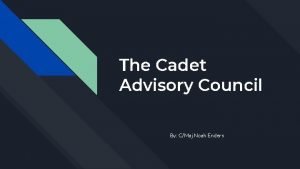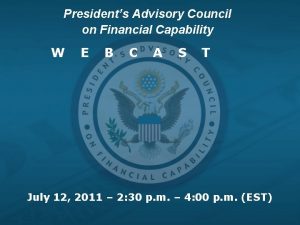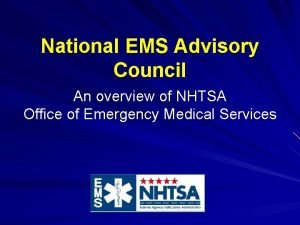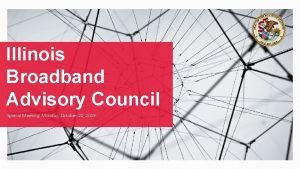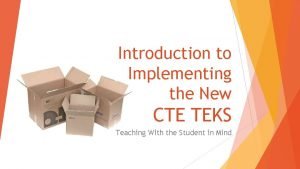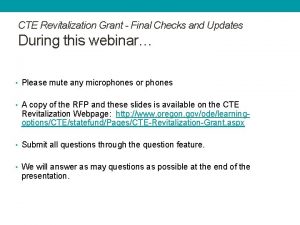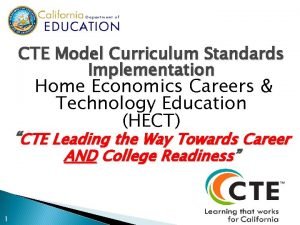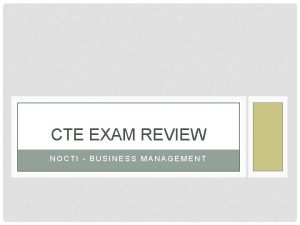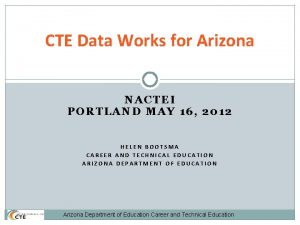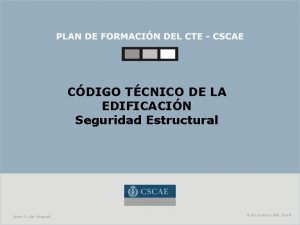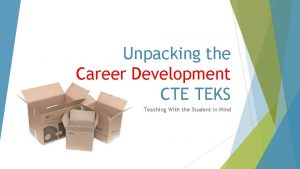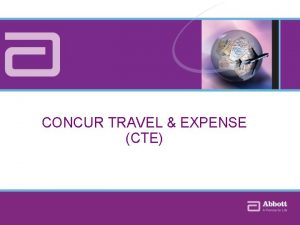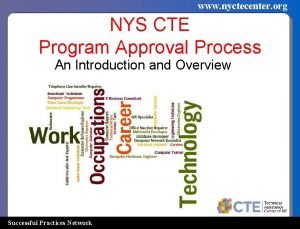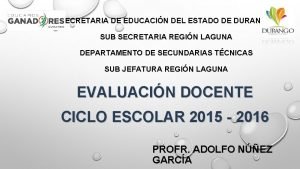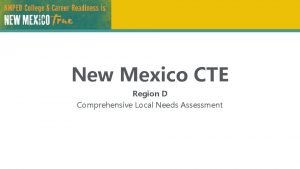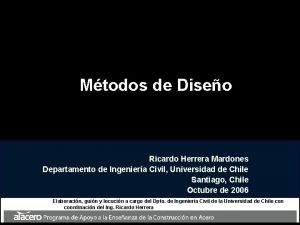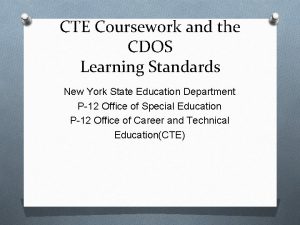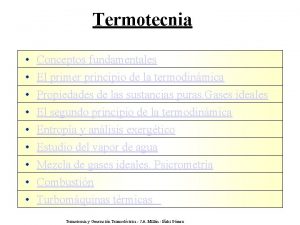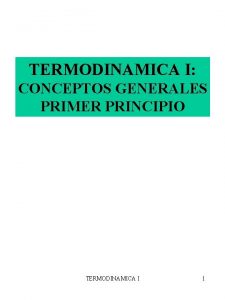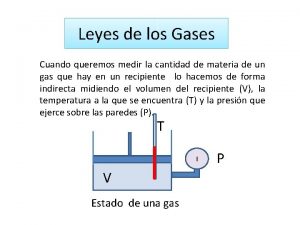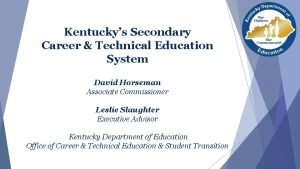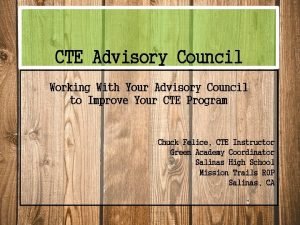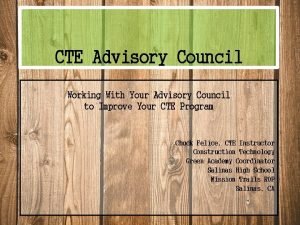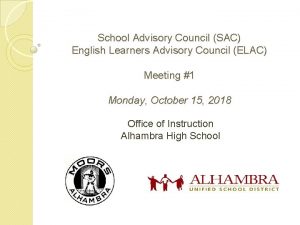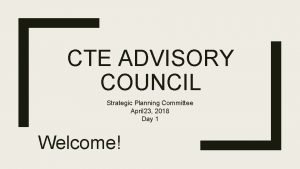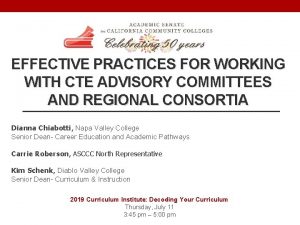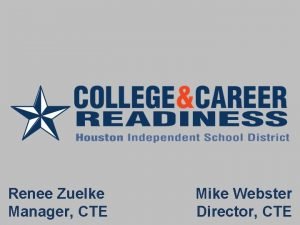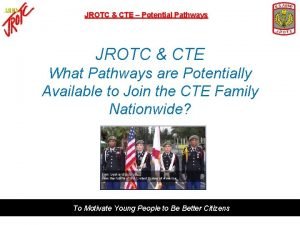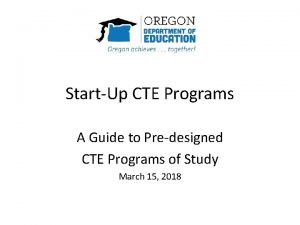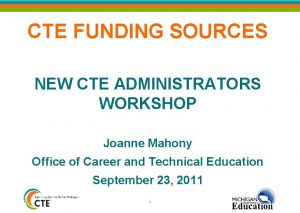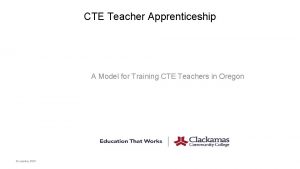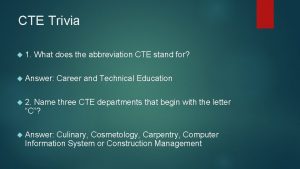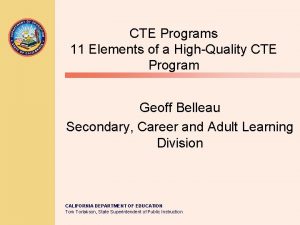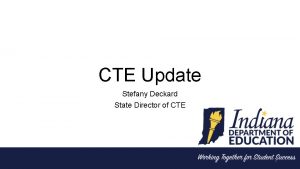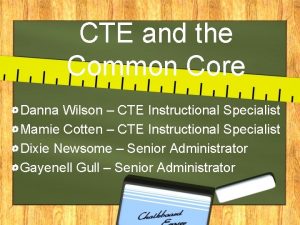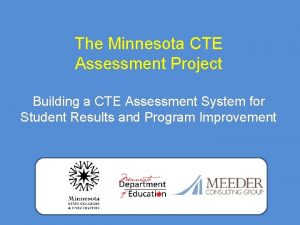CTE Advisory Council Working With Your Advisory Council


































- Slides: 34

CTE Advisory Council Working With Your Advisory Council to Improve Your CTE Program Chuck Felice, CTE Instructor Green Academy Coordinator Salinas High School Mission Trails ROP Salinas, CA

CTE Scale Value for Ranking Advisory Councils • 1 = Not Implementing • 2 = Limited Implementation (lack of participation) • 3 = Moderate Implementation (minimally developed and supported) • 4 = High Implementation (adequately supported and developed and supported) • 5 = Full Implementation (exceeds expectations)

How would you rate your Advisory Council today? Scale 1 -5 5 3 4 2 1

Six Essential Elements to Effective Career and Technical Education (from the California Department of Education 2020 Strategic Plan) • Communication and Development of a Comprehensive Career Development System • Academic Achievement through Integrated, Contextualized Instruction • Appropriate Teaching and Learning through Professional Development • The Use of Technology in Teaching and Learning • Data Driven Decision Making and Research Based Application • Transition to Post Secondary Education and the Workforce

CTE 2016 AND Beyond… The Five Star Process Improving Your CTE Program

The Five Star Management Process Roles of Local Advisory Committees Role of the Teacher Purpose Membership and Terms of Service Making Decisions & Assessing Delivery of Information

Roles of Local Advisory Committee Advise Assist Advocate

Level of Participation of an Advisory Committee • Assist with a survey of local employment needs. • Assist with a task inventory to determine the skills needed by local industry. • Advise on changes in industry standards and recommend acceptable performance standards. • Advise on new developments in technology. • Review the length of CTE programs in terms of entrylevel job skills needed by industry. • Advocate or promote awareness of the CTE program through news releases, radio and television announcements.

Role of the Teacher • Purpose • Membership • Officers and their duties • Meetings • Program of work

Nine Aspects Common to any Business or Industry 1. 2. 3. 4. 5. 6. 7. 8. 9. Business Planning Management Health Safety & Environment Finance Community Issues Principles of Technology Personal Work Habits Labor Technical & Production Skills

Business Planning 1. Business Planning How an organization plans (includes goals and objectives), type of ownership (public, private), relationship of the organization to economic, political, and social contexts assessment of needs. * * Strategic planning Assessment of customer needs and expectations

Management 2. Management Structure and process for effectively accomplishing the goals and operations of the organization using facilities, staff, resources, equipment and materials. Assessment of customer needs * * Mission statement Employee handbook

Health Safety & Environment 3. Health Safety and Environment Practices and laws affecting the employee, the surrounding community, and the environment. * Regulatory issues * Workplace safety

Finance 4. Finance Accounting and financial decisionmaking process, method of acquiring capital to operate, management of financial operations. * Capital acquisitions * Financial operations * Contracts, bidding and estimates

Community Issues 5. Community Issues Impact of the company on the community AND Impact of community on the company * * Community activities and issues Organization’s involvement in the community. Public perception/image of the company * Accessibility of facility and services

Principles of Technology 6. Principles of Technology Technological systems being used in the workplace and their contributions to the product or service of the organization. * Technology in the workplace * Continued professional training * Adaptability and learning from experience

Personal Work Habits 7. Personal Work Habits Non-technical skills and characteristics expected in the workplace * * * Positive attitude Personal fitness and appearance Readiness to work

Labor 8. Labor Rights of employees and related issues; wage, benefits, and working conditions responsibilities agreements * * Job descriptions Employee rights and * * Role of labor organizations Employment contracts and * Cultural sensitivity

Technical & Production Skills 9. Technical and Production Skills Basic skills in math, communications, computer, time management, and thinking; specific skills for production; interpersonal skills within the organization. * * * Basic academic skills Team player skills Specific production skills

Purpose/Rationale • Strong justifications exist for the establishment of local Career and Technical Education (CTE) Advisory Committees. Local advisory committees provide the means for a CTE curriculum to remain relevant to business and industry needs. Relevance of instruction is the school's assurance that graduates will be capable of performing entry-level job skills. Advisory committee members who become familiar with CTE programs, and are themselves employed in the field as well as being potential employers of graduates, have a unique perspective of a training program. They can provide an informed viewpoint that is invaluable in the educational process. • Local advisory committees create partnerships between CTE programs and the industries and public in the communities they serve. Citizens are involved in the operation of their schools, and school personnel are better able to understand the needs of the occupations being served. • Local advisory committees promote public awareness of CTE programs. Community members are given the opportunity to become familiar with all the programs offered by schools. Both formally and informally, advisory committee members communicate the operation of CTE programs to others in the community.

Membership Consider selecting or voting on groups of people in your advisory committee: • • Business owners Employee supervisors Employees Personnel directors Alumni from that CTE Program Parents CTE Students

Terms of Service It must be decided the length of appointments for advisory committee members. Many effective ways to determine length of terms are in use. Mostly, it is preferred to set a time limit for both occupational and general advisory committee terms and to define the size of the committee in writing. This procedure promotes a continuing flow of new ideas that helps keep the committee's advice current and relevant. The most common organization is three-year terms of service staggered so that one-third of the members are replaced each year. Advantages of this organization include the following: Terms are long enough for members to become thoroughly familiar with the committee's purposes and potential. Members in the second or third year of their terms add the benefit of experience while newly appointed members add fresh ideas and perspective. Members are more likely to give their time freely when the term of service is predetermined. When the terms of service are limited and defined, the question of reappointment arises. Is membership limited to one, two or more terms? Can former members be reappointed after a time lapse? Establishing policies on these issues avoids potential problems later. A disadvantage of reappointment is that a member may take it personally when some members are reappointed and others are not. However, certain members may be so valuable to a program that a system or school will want to continue their appointments. A policy of reappointment after a time lapse (usually of one year) can allow for these situations. Checklist Inform members of the length of their term of service before they accept appointment. Establish the policy for term of service at the time the committee is organized. Allow for later reviews to assess whether the term of service policy is effective. Change the policy if members, administrators, and the instructional staff agree. • n

Meetings • Article III – Meetings • Section 1. Regular meetings (2) of the advisory committee will be held (day of and months) during the calendar year. • Section 2. Written notices of meetings shall be mailed to all members at least three weeks before each meeting by the advisory committee secretary or her designated person. • Section 3. The agenda for each meeting shall be prepared by the chairperson and the Career and Technical Education administrator/instructor. Resource: Dept. of Ed.

Making Decisions Assessing Delivery of Information • DO. . . • Provide advisory committee members with a handbook explaining the purpose, operation, and organization of advisory committees; • Send a letter of appointment to each member signed by the chief school administrator or other appropriate person; • Keep advisory committee members informed of current and pending legislation affecting Career and Technical Education; • Hold meetings on an organized time schedule and adhere to the schedule; • Notify members promptly regarding actions taken as a result of their recommendations; • Send each member a letter and an agenda reminding him/her of each meeting at least two weeks in advance of the meeting; • Solicit the advice and recommendations of members regarding the effectiveness of the Career and Technical Education program and the effectiveness of advisory committee meetings; • Establish an informal atmosphere at meetings and encourage the exchange of ideas; • Mail each member a copy of the advisory committee minutes as soon as possible after each meeting; • Encourage members to visit the school's Career and Technical Education programs as often as they can; • Avoid having members do unnecessary work details that can be accomplished by the school staff; • Have a school representative attend all meetings; and • File copies of all minutes with the school's administration. • DON'T. . . • Appoint members without carefully studying their potential contributions to Career and Technical Education (Workforce Development); • Schedule meetings at inconvenient times and dates; • Hold meetings in uncomfortable facilities; • Allow members to become involved in administrative functions; • Try to organize the advisory committee without electing appropriate officers (i. e. , chairperson, vice-chairperson, and secretary); • Expect members to attend meetings without giving them prior notice, agenda items, and appropriate background material; • Discourage members from learning all they can about the school and its programs; • Discourage members from chatting with Career and Technical Education students; • Influence members in their selection of officers; • Appoint members for an indefinite term; • Fail to recognize members' contributions to the school and its programs; • Fail to replace inactive members; and • Fail to carefully consider all advisory committee recommendations and promptly inform members of action taken on each recommendation

Sample Statement of Purpose The School Board (or Board of Trustees) of __________________ authorizes the establishment of "The ____________ Occupational Advisory Committee" on this_ day of____________ 20[year]. The function of the ________________occupational advisory committee is to provide advice and counsel to the instructional and administrative staff of the___________ program and to its students. It is not given authority for policy decisions, and it is expected to operate within the guidelines set forth. The purpose of the ________________ general/ occupational advisory committee is to contribute to the improvement of _____________in education _____________________through such functions as: Name of School/or System verifying the need for instruction in the occupation; providing input on curriculum, equipment, and facilities that is both current and relevant to community needs; assisting with career guidance and student placement; and promoting community public relations. The School Board (or Board of Trustees) pledges cooperation with the committee’s work. It reserves the right to dissolve the _________________ general occupational advisory committee at any time and for any reason. The term of the committee will be continuing unless terminated by the School Board (or Board of Trustees); ________, Chairperson; __________, Superintendent (or Principal, Dean, Director, or other appropriate school official).

Sample Outline of Plans for First Meeting • After the committee members have been asked and have agreed to participate on the Committee, the process of planning for the first meeting can begin. The planning of this meeting rests primarily on the teacher until committee leadership has been established. Listed below are ten steps that can be used to plan the first meeting. • Set the date and time. The teacher should schedule the first meeting far enough in advance so that members can make arrangements to attend. In planning meeting times, the teacher must arrange the most convenient time for the majority of committee members. • Develop the agenda. (Appendix D) • Select the meeting place. The teacher should make arrangements for the meeting room. This involves ensuring that seating is comfortable. In selecting meeting sites, it is advantageous to consider using the CTE program facility so committee members can further develop an understanding of the CTE program activities as well as assess the site and equipment. • Plan refreshments. • Create nametags. • Delegate duties. Contact school site and district representatives. • Send committee members the following at least three weeks prior to the meeting: • Notice of the first meeting—include RSVP • Agenda • Purpose of the Committee meeting • (This document may be a statement from the school or system regarding the mission or goals of a CTE program advisory committee. ) • Directions, maps, and instructions for parking • Contact committee members one week in advance regarding the date, time, and location of the meeting. This serves as a welcome and a reminder. • Prepare handouts. • Prior to the first meeting, the teacher should ensure that the meeting room is set up, all equipment is functioning, and supplies are available. • Conducting the Meeting • The teacher usually chairs the first meeting or delegates the responsibility for chairing this meeting to an administrator or other informed member of the Committee. At least fifty-one percent (a majority) of the committee membership must be present to conduct business. The following is a list of suggestions for conducting the first meeting: • Begin and end the meeting on time. This step shows respect to busy committee members. • Make introductions when appropriate. Ask an administrator to welcome the Committee.

PROGRAM OF WORK • National Program of Work • The heart of Skills. USA is the program of work or what your chapter is going to do. It is the activities and projects—the plan of action—that your chapter will carry out during the school year. • The national Program of Work (POW) sets the pace for Skills. USA nationwide. The expectation is that each chapter will carry out this program of work. All of the Skills. USA programs are in some way related to the following seven major goals. • Professional Development • To prepare each Skills. USA member for entry into the workforce and provide a foundation for success in a career. Becoming a professional does not stop with acquiring a skill, but involves an increased awareness of the meaning of good citizenship and the importance of labor and management in the world of work. • Community Service • To promote and improve good will and understanding among all segments of the community through services donated by Skills. USA chapters, and to instill in its members a lifetime commitment to community service. • Employment • To increase student awareness of quality job practices and attitudes, and to increase the opportunities for employer contact and eventual employment. • Ways and Means • To plan and participate in fundraising activities to allow all members to carry out the chapter’s projects. See our special Chapter Fundraising section for more information. • Skills. USA Championships • To offer students the opportunity to demonstrate their skills and be recognized for them through competitive activities in occupational areas and leadership. • Public Relations • To make the general public aware of the good work that students in career and technical education are doing to better themselves and their community, state, nation and world. • Social Activities • To increase cooperation in the school and community through activities that allow Skills. USA members to get to know each other in something other than a business or classroom setting. • The students should discuss and develop their own plan. Your role is to help them select activities which relate to their vocational training and to guide them as they develop their personal skills in communications, organization, planning and follow-through. • Chapter activities will provide some of the best opportunities your students will have to learn by doing. A successful program of work creates a positive learning atmosphere in the classroom and shop. Your students learn how to accept responsibility, work as a team, manage a budget, and handle success and failure.

Sample CTE Advisory Council Activity List/Survey • Designate a group or individual in your business to select and recruit other employees for CTE activities. • Serve on CTE steering committees and boards. • Develop and provide mentorship, job-shadow and work experience opportunities, and apprenticeship programs for students. • Volunteer even if you are involved in a small business; speak in a classroom or offer a job-shadow experience; share your business experiences; and discuss the tasks involved in running a business. • Choose a school in your community to “adopt” and create a plan to work with administrators, teachers, and students on CTE activities. Plan to involve primary, secondary, and postsecondary CTE interests. • Allow employees time off to speak in classrooms and work with teachers on curriculum development that is relevant to your business and the broader world of work. • Work with a school to develop mastery certificates that reflect skills students must have for entry into a specific business. • Assist students with obtaining program credentialing. • Offer activities for students such as tours of your business. • Participate in job fairs. • Host a speaker on CTE for a meeting or consider a CTE activity as a future project if you are a member of a business or civic organization. • Offer summer internships for teachers so they can take firsthand business experience back to their classrooms and integrate what they learned into their curriculum. • Provide testimonials and encouragement to other employers. efforts at business and civic organizations. • Publicize CTE connections in company newsletters, local newspapers, trade magazines, and business publications. • Participate in CTE planning groups in your state and school district. Serve on school boards. • Develop programs to train business/industry members as CTE mentors. • Include articles in newsletters to your members about the benefits of CTE and examples of opportunities created through employer/education partnerships. • Work with employers to provide work-based learning opportunities for students and teachers. • Involve teacher organizations in the restructuring of education, including integrating academic and work-based learning. • Promote the inclusion of employer involvement in CTE activities in collective bargaining agreements. • Communicate with others about the benefits of career and technical education activities. Build public awareness by offering employees to speak about your company’s CTE

SAMPLE LETTER Mill Cabinet • Save the date. docx • Advisory. Inviteon. ROPletterhead. Single. docx • SIGNin. doc

SAMPLE AGENDA Mill Cabinet Advisory Committee • Agenda. FALLor. SPRING. docx • Agenda. FALL 2015. docx

Sample Advisory Meeting Minutes Mill Cabinet Minutes • Employee. Committee. Meeting. Minutes. Fallor. Spring. docx

Sample Thank You Letter • • • • • • • (Send on School Letterhead) Date Committee Member’s Name Street City, Tennessee ZIP Dear (Committee Member’s Name): Thank you for the time, talent, and expertise you have given to (CTE program name). You have made a difference through your dedication and continued support of (CTE program name) and (CTSO name). Your ideas, input, and enthusiasm were most helpful and have assisted us in making valid improvements to our program. • (Personalize this paragraph to include changes that have occurred related to your program through the assistance of the advisory committee). The minutes from the last meeting are enclosed for your review. • Again, our principal, (Principal’s Name), and I thank you for your contributions, time, and efforts through serving on this committee. • Sincerely, • Teacher’s Name • Program Name • Reference Initials • cc: (Important people who should receive notification of person’s contribution - employer)

Mill Cabinet Advisory List Certificateback 2. doc Committee list. xlsx

Sample News Release • (Note: Your central office may have its own policies about who can send information to the media and the format of that information. The news release should be double-spaced. Newspapers do not use courtesy titles [Mr. , Miss, Mrs. ] or commas between the name and a suffix (Jr. , Sr. , III). End the release with ### or – 30 – centered at the bottom. ) • For Immediate Release • For more information, contact (name) at (contact number) • (This is the person the media should contact if more information is needed about the release. ) • (Fill in how many) representatives of area businesses, industries, and community agencies have been named to a committee that will provide input and recommendations to the career and technical (specify program) at (your school name). • The Career and Technical Education Program Advisory Committee will provide advice and assistance to ensure that the program curriculum at (your school name) remains relevant by reflecting current technology and trends in the industry. The Committee reviewed the Business/Industry Certification standards for the program. • “We will use recommendations by members of business, industry, and community agencies as part of our commitment to provide fresh approaches to instruction and emphasize new ideas and technology in the curriculum, ” said (your teacher, your principal, or your superintendent). • Members of the career and technical education program advisory committee at (your school) are (list committee member(s) name(s) and employer/agency). • For more information on the career and technical education program, contact (teacher’s name).
 Ciogino sach
Ciogino sach Cadet advisory council
Cadet advisory council Source selection
Source selection President's advisory council on financial capability
President's advisory council on financial capability National ems advisory council
National ems advisory council Illinois broadband advisory council
Illinois broadband advisory council German advisory council on global change
German advisory council on global change Oregon broadband advisory council
Oregon broadband advisory council Hard work vs smart work
Hard work vs smart work Advantages of hot working over cold working
Advantages of hot working over cold working Hot working and cold working difference
Hot working and cold working difference Differentiate between hot working and cold working
Differentiate between hot working and cold working Examples of cold working and hot working
Examples of cold working and hot working Cte meaning
Cte meaning Cte revitalization grant
Cte revitalization grant Cte anchor standards
Cte anchor standards Define cte
Define cte Cte technical skills assessments.azed.gov/student
Cte technical skills assessments.azed.gov/student Cte seguridad estructural
Cte seguridad estructural Afnr teks
Afnr teks Transformation isochore
Transformation isochore Oneconcur abbott
Oneconcur abbott Cte tac
Cte tac Plataforma cte durango
Plataforma cte durango Cte school new mexico
Cte school new mexico Cargas muertas cte
Cargas muertas cte Cdos learning standards
Cdos learning standards Cte programs of study
Cte programs of study V=cte
V=cte Teks cte
Teks cte Termotecnia pdf
Termotecnia pdf Sistema hidrostatico termodinamica
Sistema hidrostatico termodinamica Ecuacion de los gases ideales
Ecuacion de los gases ideales David horseman
David horseman Formula de volumen especifico
Formula de volumen especifico

